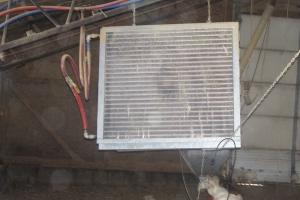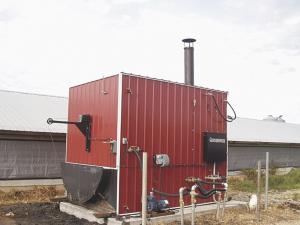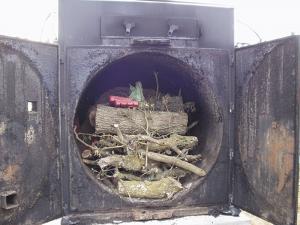Bale Burner Keeps Birds Warm, Healthy
When it cost Larry Morrison $14,000 for propane to raise one 40-day flock of chickens last year, the Missouri poultry farmer knew something had to change. He purchased a hay bale burner from Agri-Flame, a company that got its start after reading a FARM SHOW article about a Canadian-made bale-burning stove.
Based on his experience with the stove late last winter, Morrison expects this winter's heating bill to be much cheaper. He already has a couple barns filled with $10 bales and about $1,500 worth of slab wood.
Besides fuel cost savings of up to 80 percent, he discovered a couple other benefits of his new heating system.
"I found out it wasn't as much work as we all thought," says Morrison who's nearly 70 and has health problems. "The other surprise is how much better the air is and how much it improved the health of the birds."
Unlike the moist heat of propane, which works exhaust fans harder, the hydroponics system delivers heat through hot water lines and radiators, which produce a drier heat that Morrison feels is healthier for the birds. The flock he raised with his new system came in No. 1 out of 13 contract growers.
The $85,000 system includes a 10 by 8- ft. furnace with a 7-ft. door to load round hay bales, a 4,000-gal. water tank, water lines, and five radiators with fans for each of Morrison's four 40 by 400-ft. chicken houses.
As he operated the system for the first time, the Monett, Mo., farmer learned a few things. First, hay bales must be kept dry at 15 percent or less moisture. However, the stove will burn green wood slabs once the fire is hot. Morrison can pick up both bales and wood slabs inexpensively where he lives. Alternating wood with hay dries up the creosote from the wood, avoiding problems. The stove is also capable of burning regular firewood and bales of other dry, biomass materials.
In cold weather Morrison burned 4 to 5 bales a day. He put in 2 at a time for overnight and added another bale at 3 a.m. This year he may use more wood slabs overnight.
"I use propane as a backup," Morrison says, noting it didn't kick in much last year, but is an important - and required - safety backup.
With a USDA energy grant paying $25,000, and hopefully continuing to earn higher prices for healthier chickens, the system should pay for itself faster than expected. He's willing to talk to other producers who have questions about hay-burner heating systems.
Contact: FARM SHOW Followup, Larry Morrison, 11883 Hwy. BB, Monett, Mo. 65708 (ph 417 235-8468; Morrison@cwnet.com; www.agriflame.com).

Click here to download page story appeared in.
Click here to read entire issue
Bale Burner Keeps Birds Warm, Healthy ENERGY Crop Residue Burners 33-5-42 When it cost Larry Morrison $14,000 for propane to raise one 40-day flock of chickens last year, the Missouri poultry farmer knew something had to change. He purchased a hay bale burner from Agri-Flame, a company that got its start after reading a FARM SHOW article about a Canadian-made bale-burning stove.
Based on his experience with the stove late last winter, Morrison expects this winter's heating bill to be much cheaper. He already has a couple barns filled with $10 bales and about $1,500 worth of slab wood.
Besides fuel cost savings of up to 80 percent, he discovered a couple other benefits of his new heating system.
"I found out it wasn't as much work as we all thought," says Morrison who's nearly 70 and has health problems. "The other surprise is how much better the air is and how much it improved the health of the birds."
Unlike the moist heat of propane, which works exhaust fans harder, the hydroponics system delivers heat through hot water lines and radiators, which produce a drier heat that Morrison feels is healthier for the birds. The flock he raised with his new system came in No. 1 out of 13 contract growers.
The $85,000 system includes a 10 by 8- ft. furnace with a 7-ft. door to load round hay bales, a 4,000-gal. water tank, water lines, and five radiators with fans for each of Morrison's four 40 by 400-ft. chicken houses.
As he operated the system for the first time, the Monett, Mo., farmer learned a few things. First, hay bales must be kept dry at 15 percent or less moisture. However, the stove will burn green wood slabs once the fire is hot. Morrison can pick up both bales and wood slabs inexpensively where he lives. Alternating wood with hay dries up the creosote from the wood, avoiding problems. The stove is also capable of burning regular firewood and bales of other dry, biomass materials.
In cold weather Morrison burned 4 to 5 bales a day. He put in 2 at a time for overnight and added another bale at 3 a.m. This year he may use more wood slabs overnight.
"I use propane as a backup," Morrison says, noting it didn't kick in much last year, but is an important - and required - safety backup.
With a USDA energy grant paying $25,000, and hopefully continuing to earn higher prices for healthier chickens, the system should pay for itself faster than expected. He's willing to talk to other producers who have questions about hay-burner heating systems.
Contact: FARM SHOW Followup, Larry Morrison, 11883 Hwy. BB, Monett, Mo. 65708 (ph 417 235-8468; Morrison@cwnet.com; www.agriflame.com).
To read the rest of this story, download this issue below or click
here to register with your account number.









